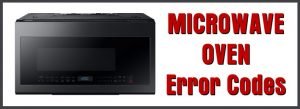
The “OE” error code is mostly linked to the microwave’s sensor systems. Think of your smartphone when it gets confused and needs a reboot. Your microwave is kind of in the same boat when it shows this code—it’s basically telling you that something’s not quite right with its temperature detection or ventilation. And just like with gadgets, these hiccups can usually be traced back to a few common culprits.
Understanding the Role of Microwave Sensors
Microwaves might seem like simple machines, but they’re equipped with some pretty nifty technology under the hood. At the heart of many error codes, including “OE”, are the sensors that help your microwave cook food evenly and safely. These sensors act like the microwave’s eyes and nose, constantly monitoring temperature and humidity to ensure everything’s working smoothly. If one of these sensors gets out of whack, it can send a distress signal in the form of an error code.
Imagine your microwave’s sensor as a thermostat in your home. If it reads the room temperature wrong, you could end up sweating in the middle of winter or shivering in summer. Similarly, a malfunctioning sensor in your microwave can think things are way hotter (or cooler) than they really are, causing it to flash the “OE” code as a cry for help. Often, this can be because the sensor is dirty, misaligned, or just getting a little too old.
To solve this, you might simply need to give your microwave a good clean. Sometimes, steam and food particles can gunk up the sensors, leading them to misread the situation. If cleaning doesn’t help, it might be worth consulting the user manual or reaching out to Samsung support for guidance on recalibrating or replacing the sensor.
Ventilation and Its Impact on Error Codes
Now, let’s chat about another important player: your microwave’s ventilation system. Just like a car engine needs airflow to run efficiently, your microwave needs proper ventilation to avoid overheating. If something’s blocking the airflow, the insides can get too hot, triggering that pesky “OE” code to pop up.
Think of it like trying to run a marathon while wearing a heavy winter coat. You’d get hot and uncomfortable pretty quickly, right? Your microwave feels the same way. It needs to breathe to function properly. Dust, grease, or even a misplaced microwave can all lead to ventilation issues. If it’s been a while since you’ve cleared out the vents, it might be time for a little TLC.
If you suspect ventilation is causing the issue, ensure your microwave has enough space around it for air to circulate. Also, take a peek at any filters or vents and give them a clean. This small action might just be the breath of fresh air your microwave needs to get back on track.
Power Supply and Electrical Issues
Alright, let’s dig into another possible cause: electrical issues. Your microwave, like all electronic devices, relies on a stable power supply to do its job. If there’s a disruption—maybe a power surge or a faulty outlet—it can lead to errors like “OE” popping up.
Picture your microwave as a high-performance athlete. If it doesn’t get the right kind of energy supply, it can’t function at its peak. Similarly, if your microwave isn’t receiving a consistent flow of electricity, it might throw up an error code as a sign of distress. This could be due to loose connections, damaged power cords, or even inconsistencies in your home’s electrical system.
Troubleshooting electrical issues can be a bit tricky and might require a multimeter or the assistance of a qualified electrician. But before you call in the pros, try unplugging the microwave for a few minutes before plugging it back in. Sometimes, a simple reset can clear temporary glitches and restore normal function.
Preventative Tips and Final Thoughts
So, what can you do to prevent the dreaded “OE” error code? Regular maintenance is your best friend. Make it a habit to clean the inside of your microwave, paying careful attention to sensors and vents. Also, ensure that it’s placed in a well-ventilated area to avoid overheating.
Additionally, keeping an eye on how and when the error occurs can provide valuable clues. Does the error appear after cooking certain foods, or does it seem to happen randomly? Noting these patterns can be helpful when seeking professional assistance.
In conclusion, while the “OE” error code might seem daunting at first, it’s often just your microwave’s way of saying it needs a little bit of attention. With some careful observation and routine maintenance, you can keep your microwave running smoothly and avoid those unwelcome surprises in the future. And remember, when in doubt, don’t hesitate to seek help from an expert—after all, it’s always better to be safe than sorry!